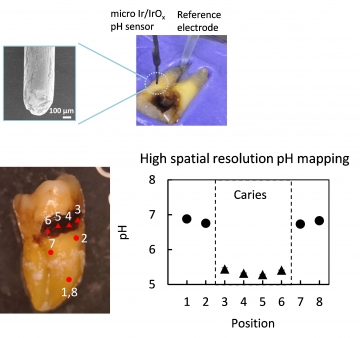"New microsensor for pH mapping joins the fight against tooth decay"
Researchers at Tokyo Medical and Dental University (TMDU) have created a small sensor that can noninvasively measure pH at specific sites and within cavities in teeth, providing a means of identifying tooth decay at an early stage
Tokyo, Japan – Tooth decay, also known as dental caries, is a major health problem affecting the quality of life of large numbers of people. It is known to be caused by products released by bacteria on the surface of teeth, but there has been difficulty in diagnosing it at an early stage, meaning that many patients have progressed to a more severe stage before receiving treatment.
In a new study reported in the journal Analytical Chemistry, researchers at Tokyo Medical and Dental University (TMDU) have created a pH sensor that can identify regions of acidity on teeth related to caries-causing bacteria without the need for subjective judgments by dentists, or the exposure of patients to investigative methods involving X-rays or other harmful procedures (Figure). The device provides accurate and quantitative findings on the vulnerability of teeth decay.
Tokyo, Japan – Tooth decay, also known as dental caries, is a major health problem affecting the quality of life of large numbers of people. It is known to be caused by products released by bacteria on the surface of teeth, but there has been difficulty in diagnosing it at an early stage, meaning that many patients have progressed to a more severe stage before receiving treatment.
In a new study reported in the journal Analytical Chemistry, researchers at Tokyo Medical and Dental University (TMDU) have created a pH sensor that can identify regions of acidity on teeth related to caries-causing bacteria without the need for subjective judgments by dentists, or the exposure of patients to investigative methods involving X-rays or other harmful procedures (Figure). The device provides accurate and quantitative findings on the vulnerability of teeth decay.

Fig:Quantitative analysis of caries activity using micro Ir/IrOx pH sensor
Quantitative dental caries analysis was successfully evaluated using a micro pH sensor with a diameter of 0.3 mm.
This sensor is based on iridium oxide and has a diameter of only one-thirtieth of a centimeter, meaning that the device can be used to analyze small specific patches of tooth surfaces where localized caries may have become established. The small dimensions of the sensor also mean that it can be used to analyze cavities or closely apposing surfaces of teeth, sites where conventional visual examinations cannot be performed.
“After creating this sensor and testing its accuracy on standard pH solutions, we analyzed it using 18 extracted human teeth with different levels of caries,” says Yuji Miyahara at TMDU’s Institute of Biomaterials and Bioengineering. “It could identify significant differences in pH levels among sites known to have active caries, sites with arrested caries, and healthy unaffected roots.”
The team also found that the results obtained with the new sensor matched well with the findings of visual inspection by a dentist, suggesting that this approach is robust and reliable. It can avoid any subjectivity associated with the conventional visual analysis by providing an objective, quantitative screening tool.
According to Miyuki Tabata, “This new tool should help us to identify tooth decay at an earlier stage, enabling better and less invasive treatments.” She adds, “It also helps us to distinguish between cases of active caries and cases of arrested caries in which remineralization has started to occur, for which different treatments would be applied.”
The article “pH Mapping of Tooth Surfaces for Quantitative Caries Diagnosis Using Micro Ir/IrOx pH Sensor” is published in Analytical Chemistry at doi: 10.1021/acs.analchem.8b00867.
“After creating this sensor and testing its accuracy on standard pH solutions, we analyzed it using 18 extracted human teeth with different levels of caries,” says Yuji Miyahara at TMDU’s Institute of Biomaterials and Bioengineering. “It could identify significant differences in pH levels among sites known to have active caries, sites with arrested caries, and healthy unaffected roots.”
The team also found that the results obtained with the new sensor matched well with the findings of visual inspection by a dentist, suggesting that this approach is robust and reliable. It can avoid any subjectivity associated with the conventional visual analysis by providing an objective, quantitative screening tool.
According to Miyuki Tabata, “This new tool should help us to identify tooth decay at an earlier stage, enabling better and less invasive treatments.” She adds, “It also helps us to distinguish between cases of active caries and cases of arrested caries in which remineralization has started to occur, for which different treatments would be applied.”
The article “pH Mapping of Tooth Surfaces for Quantitative Caries Diagnosis Using Micro Ir/IrOx pH Sensor” is published in Analytical Chemistry at doi: 10.1021/acs.analchem.8b00867.
Summary:
Researchers at Tokyo Medical and Dental University (TMDU) created a microsensor that can
determine the pH on tooth surfaces at high resolution. They tested the device on standard pH
solutions to confirm its reliability, and then applied it to extracted tooth samples with different levels of
decay. The findings showed that the device distinguished among sites with active, arrested, or no
caries, and matched the findings obtained upon visual examination by a dentist.
determine the pH on tooth surfaces at high resolution. They tested the device on standard pH
solutions to confirm its reliability, and then applied it to extracted tooth samples with different levels of
decay. The findings showed that the device distinguished among sites with active, arrested, or no
caries, and matched the findings obtained upon visual examination by a dentist.
Correspondence to:
Miyuki TABATA, Ph.D., Assistant Professor
Department of Bioelectronics,
Institute of Biomaterials and Bioengineering,
Tokyo Medical and Dental University(TMDU)
E-mail:tabata.bsr(at)tmd.ac.jp
Department of Bioelectronics,
Institute of Biomaterials and Bioengineering,
Tokyo Medical and Dental University(TMDU)
E-mail:tabata.bsr(at)tmd.ac.jp

